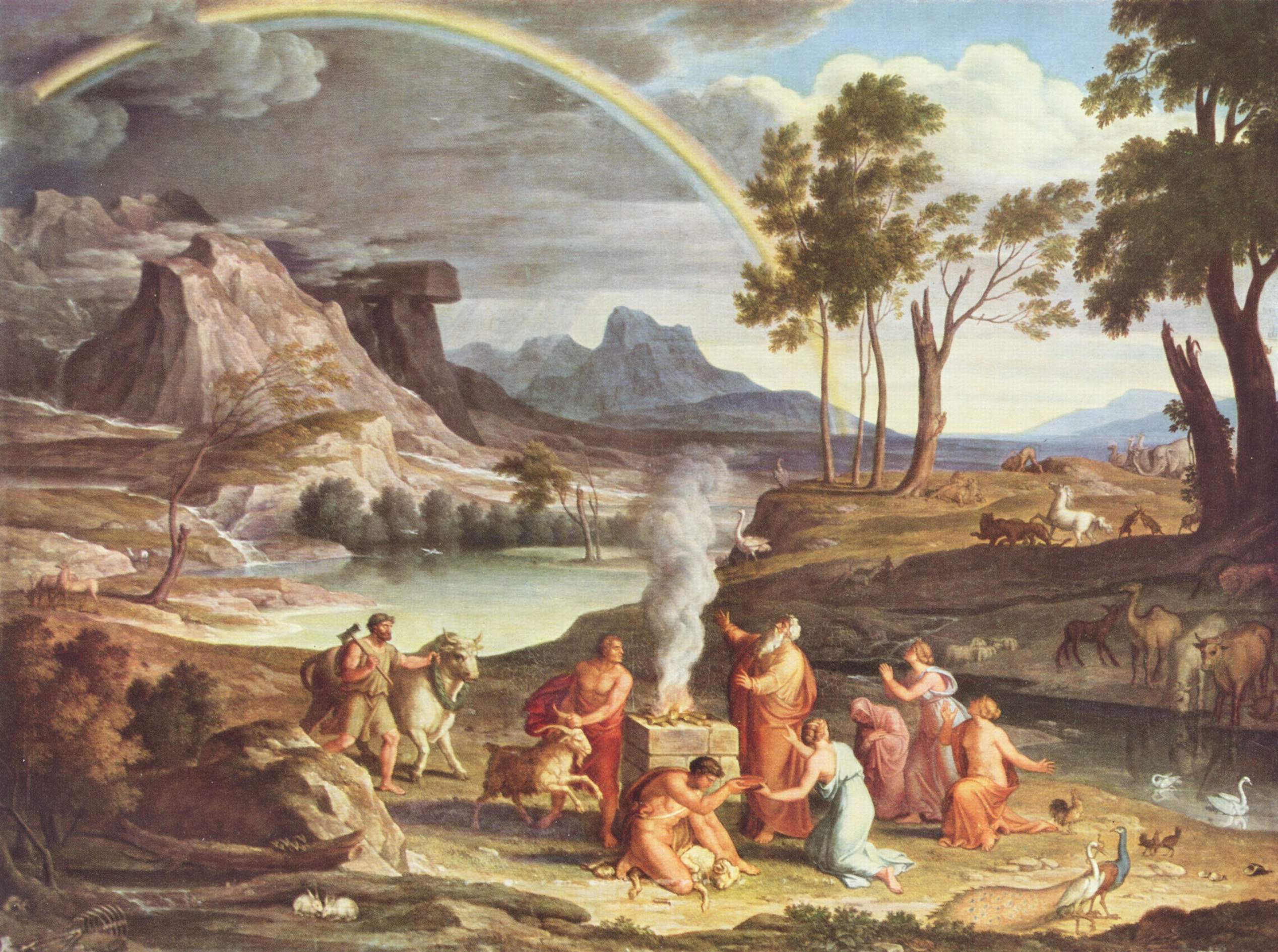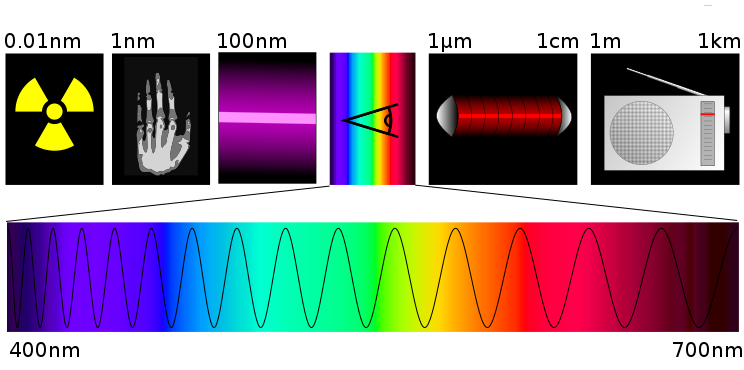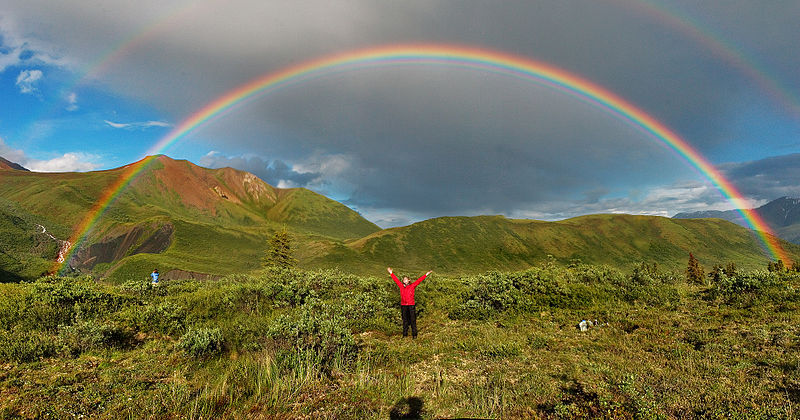 A rainbow is a beautiful sight.
A rainbow is a beautiful sight.Rainbows have inspired people for ages, spawning many myths and poems.
There are those who think that knowledge of how a rainbow works somehow destroys that beauty. Here are some lines from Keats' poem, "Lamia", lamenting Newton's insights into optics that let us see inside the workings of the rainbow:
Do not all charms flyI can almost understand his sorrow - mystery is beautiful, and when knowledge expands, mystery seems to retreat.
At the mere touch of cold philosophy?
There was an awful rainbow once in heaven:
We know her woof, her texture; she is given
In the dull catalogue of common things.
Philosophy will clip an Angel’s wings,
Conquer all mysteries by rule and line,
Empty the haunted air, and gnomed mine—-
Unweave a rainbow, as it erewhile made
The tender-person’d Lamia melt into a shade.
But what a narrow view of the world, to think that more knowledge, more understanding, somehow robs the world of its mystery and its beauty. Let me relate a personal account.
It begins with a book, whose name is taken from the passage above. In Unweaving the Rainbow, Richard Dawkins shows not only the glory and delight of discovery that lies at the root of scientific pursuits. He gives us a glimpse of the deeper beauty revealed by those pursuits.
 He reminds us (for example) that Newton's work on optics has been carried on. We now know that visible light - spanning the colours of the rainbow - is but a tiny slice of a great continuum. The electromagnetic spectrum extends off the red end of the rainbow into infrared and radio waves. Off the other end, we get ultraviolet, x-ray, and gamma waves.
He reminds us (for example) that Newton's work on optics has been carried on. We now know that visible light - spanning the colours of the rainbow - is but a tiny slice of a great continuum. The electromagnetic spectrum extends off the red end of the rainbow into infrared and radio waves. Off the other end, we get ultraviolet, x-ray, and gamma waves.The rainbow we see is only a fragment - the tiny slice of that greater spectrum, visible to our pragmatically-evolved eyes.
I was on a train, some weeks after reading Dawkins' thoughts. Looking out the window, I saw a rainbow, gliding along the nearby hills, keeping pace with us. It was soft and faint, as beautiful as the first rainbow I ever saw as a child.
But this time there was something more. As I stared at it, I thought of it not simply as a strip of colours, but as something greater and deeper - the full spectrum of light. Of course, I still didn't see those other colours. Knowledge had not altered my eyes at all. But it was as if I could almost feel them.
Like when you hear a loved one walk up behind you. All that you physically sense is the sound. But you know what they look like, how they walk, how they stand. How tall they are. How likely they are to tickle you if they get close enough. With the sound of their steps and their breathing, your mind calls up all of this knowledge, filling in the experience for you so that you can almost see the person behind you, almost feel their movements and expressions.
In just that way, I felt the invisible rainbow filling the sky outside my train - down to the centre of the arc and out as far as the sky went. It was magnificent. Such glory; such encompassing beauty.
Beauty that I would never have known if the rainbow had not been "unwoven".
Thankyou, Richard Dawkins, for helping me to see this. Thankyou to every scientist who gives us the chance to see the unseen, hear the unheard, touch the untouchable.
We are, and forever will be, surrounded by a sea of mystery. What delight to be able to reach into it, to see the wondrous glory that is only accessible by the tools of science - Keats' "cold philosophy". Cold? The thought of all the knowledge, all the enrichment of subjective experience that science can give us, warms my very being.
I wish I could show Keats the rainbow I now see, thanks to scientists like Newton. But I'll have to content myself by sharing it with you. May you feel the same exhilaration I feel at the sight of every rainbow!

Photo credits:
The rainbow images are from the Wikipedia article on rainbows. The first is public domain; the second is licenced under an Attribution ShareAlike Creative Commons licence by its creator, Eric Rolph.
The spectrum illustration is from the Wikipedia article on the electromagnetic spectrum. It is licenced under an Attribution ShareAlike Creative Commons licence by its creator, Tatoute.




One of the questions you fairly regularly get asked in oral classes whilst learning a language is to describe your favourite book. Without fail, since I read Unweaving the Rainbow, it's been that every time (although translating the title can be a bit difficult). It's beautifully written and I always recommend it to anyone who isn't enthusiastic about science.
ReplyDeleteWhat's best about science is that it gives us appreciation of things in an entirely new way, instead of us getting bored of looking at things from the same, stagnant, immobile position. The opening section "We are all going to die, and that makes us the lucky ones. Most people are never going to die because they are never going to live..." puts a new perspective on our very existence (although Dennett questions its truthfulness). Many people have that read at their funerals.
A very elegant post. I have never read that particular book of Dawkins, but you have inspired me to seek it out.
ReplyDeleteI concur with The Humainist--beautiful post and definitely a book I should read. I actually enjoy Dawkins' writing, even though I (obviously) disagree with a great deal of what he says!
ReplyDeleteBTW, if you haven't read it, you might also enjoy Bill Bryson's book A Short History of Nearly Everything. it isn't short (heh) but it definitely expresses that sense of wonder at the way the world works and the way scientific exploration proceeds. I also really enjoyed Brian Greene's books for the same reason (The Elegant Universe and The Fabric of the Cosmos), though they are a bit more controversial.
A similar idea is developed over at the excellent Daylight Atheism blog in this post.
ReplyDelete